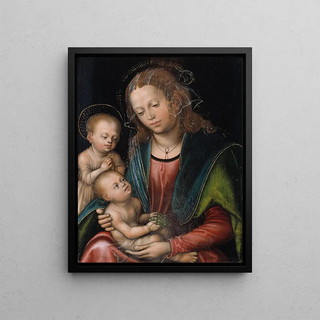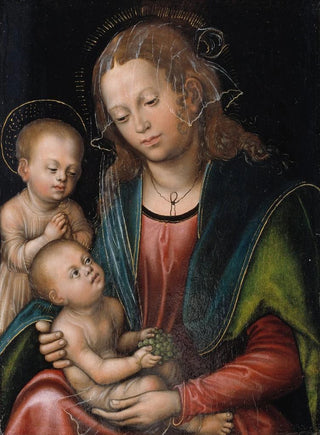Art print | Virgin and Child adored by Saint John the Child - Lucas Cranach the Elder


View from behind

Frame (optional)
Lucas Cranach the Elder's "Virgin and Child adored by the young Saint John" is a masterpiece that transcends mere artistic boundaries to immerse the viewer in an atmosphere filled with serenity and devotion. This painting, emblematic of the German Renaissance, invites us to contemplate a scene where maternal love and childhood purity converge. The depiction of the Virgin, surrounded by her two children, evokes a moment of intimacy and tenderness, as if time has stood still to immortalize this sacred union. Every detail, every color, and every expression are carefully orchestrated to convey a profound emotion, making the work timeless and universal.
Style and uniqueness of the work
Cranach's style is distinguished by its bold use of colors and finesse in rendering faces. In this piece, the softness of the Virgin and children's features is accentuated by delicate nuances that create a captivating play of light. The composition, both balanced and harmonious, highlights the relationship between the characters while incorporating symbolic elements that enrich the visual narrative. The drapery, of great elegance, is painted with meticulous attention to detail that demonstrates the artist's technical mastery. The presence of the young Saint John, with his admiring gaze, reinforces the idea of veneration and innocence, placing the work within a spiritual and contemplative dimension. Cranach's stylistic singularity, blending realism and idealism, makes this painting an essential masterpiece.
The artist and his influence
Lucas Cranach the Elder, an iconic figure of the Renaissance, knew how to leave his mark on his era through his artistic innovations and bold iconographic choices. Born in 1472, he was one of the leading representatives of Protestant art, using his painting to convey religious and moral messages. His work is characterized by a wide variety of themes, ranging from portraits to mythological scenes, but it is in the depiction of the Virgin and Child that he reaches a peak of sensitivity.

Matte finish

View from behind

Frame (optional)
Lucas Cranach the Elder's "Virgin and Child adored by the young Saint John" is a masterpiece that transcends mere artistic boundaries to immerse the viewer in an atmosphere filled with serenity and devotion. This painting, emblematic of the German Renaissance, invites us to contemplate a scene where maternal love and childhood purity converge. The depiction of the Virgin, surrounded by her two children, evokes a moment of intimacy and tenderness, as if time has stood still to immortalize this sacred union. Every detail, every color, and every expression are carefully orchestrated to convey a profound emotion, making the work timeless and universal.
Style and uniqueness of the work
Cranach's style is distinguished by its bold use of colors and finesse in rendering faces. In this piece, the softness of the Virgin and children's features is accentuated by delicate nuances that create a captivating play of light. The composition, both balanced and harmonious, highlights the relationship between the characters while incorporating symbolic elements that enrich the visual narrative. The drapery, of great elegance, is painted with meticulous attention to detail that demonstrates the artist's technical mastery. The presence of the young Saint John, with his admiring gaze, reinforces the idea of veneration and innocence, placing the work within a spiritual and contemplative dimension. Cranach's stylistic singularity, blending realism and idealism, makes this painting an essential masterpiece.
The artist and his influence
Lucas Cranach the Elder, an iconic figure of the Renaissance, knew how to leave his mark on his era through his artistic innovations and bold iconographic choices. Born in 1472, he was one of the leading representatives of Protestant art, using his painting to convey religious and moral messages. His work is characterized by a wide variety of themes, ranging from portraits to mythological scenes, but it is in the depiction of the Virgin and Child that he reaches a peak of sensitivity.






